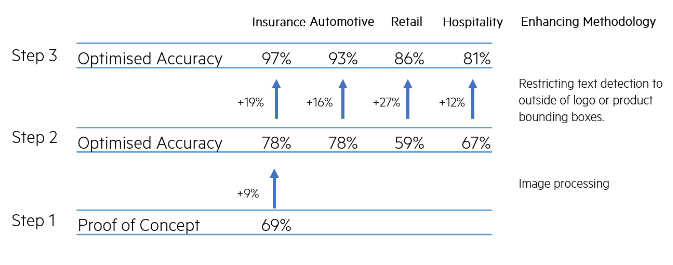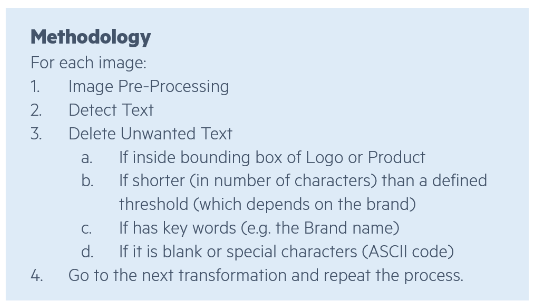
This article is Part III of a set of five technical articles that accompany a whitepaper written in collaboration between Meta and Ekimetrics. Object Detection (OD) and Optical Character Recognition (OCR) were used to detect specific features in creative images, such as faces, smiles, text, brand logos, etc. Then, in combination with impressions data, marketing mix models were used to investigate what objects, or combinations of objects in creative images in marketing campaigns, drive higher ROIs. In this Part III we explore the methodology for using Tesseract to detect text in creative images.
Detecting Text with Tesseract
In this work, Tesseract was used to detect text in all images, in a process outlined in Figure 1. Performance of this detection tool was done using Confusion Matrices, to gain insight not only into the Accuracy, but also other metrics such as the True Positive and True Negative Rates.
Figure 1 - Three stage process by which the basic performance (accuracy) of Tesseract on the original images was improved by up to 28% points.
- For general Text (both non-promotional Text and Promotional Text), the Accuracy is 69%, the True Positive Rate is around 65%, the False Positive Rate is about 35%.
- Tesseract does not recognise symbols such as % (which may indicate promotional text) accurately.
- Tesseract does not perform well on images that have a busy background.
- Tesseract does not recognise slanted Text.
Based on the low total volume of Promotional Text in our dataset, as well as the poor performance of Tesseract to detect Promotional Text, the decision was made to remove Promotional Text as one of the desired objects to study.
Building on those learnings, we implemented a pipeline, outlined in Figure 2, that would help us improve the performance from baseline, by up to 28 percentage points on Accuracy :
Figure 2 - Pipeline for pre-processing images before Optical Character Recognition Models, and correcting detected text.
For Step 1, pre-processing methods included the following, as well as combinations of those (illustrated in Figure 3): Binary Threshold, Sharpen, Normalisation, Histogram Equalisation, Histogram Adaptive Equalisation. As can be imagined, a processing method that enhances the performance of the detection method for one image, might decrease it for different images. Therefore, to ensure we obtained the highest accuracy for all images, we applied all pre-processing methods to all images, running Tesseract on each modified image, and keeping track of the text detected in each iteration.
Figure 3 - Effect of various image processing methods on the original. Images for illustrative purposes. Original images sourced from unsplash.com
With the current methodology (figure 2), the accuracy cannot be improved any further by changing the length of text that is considered to be “true” Text. Furthermore, there is a trade-off between the True Negative Rate and the True Positive Rate, which helped us choose a threshold for the length of string to accept: Since Accuracy does not improve further after length 4, but this value does optimise the other two metrics, 4 characters long is the threshold chosen.
Code snippets
Install required libraries
# To install tesseract
# !sh apt-get -f -y install tesseract-ocr
!sudo apt-get install tesseract-ocr -y
# To install pytesseract
!pip3 install pytesseract
Import required libraries
import pytesseract
from sklearn.metrics import confusion_matrix, accuracy_score
import cv2
from PIL import Image
Processing images
def normalise_img(image):
# normalise original and detect
norm_img = np.zeros((image.shape[0], image.shape[1]))
normalised = cv2.normalize(image, norm_img, 0, 255, cv2.NORM_MINMAX)
normalised = cv2.threshold(normalised, 100, 255, cv2.THRESH_BINARY)[1]
normalised = cv2.GaussianBlur(normalised, (1, 1), 0)
return normalised
def threshold_image(image, threshold=200):
image = cv2.threshold(image, threshold, 255, cv2.THRESH_BINARY)[1]
return image
def remove_noise_and_smooth(image):
# convert to grayscale
gray = cv2.cvtColor(image, cv2.COLOR_BGR2GRAY)
# blur
blur = cv2.GaussianBlur(gray, (0,0), sigmaX=33, sigmaY=33)
# divide
divide = cv2.divide(gray, blur, scale=255)
# otsu threshold
thresh = cv2.threshold(divide, 0, 255, cv2.THRESH_BINARY+cv2.THRESH_OTSU)[1]
# apply morphology
kernel = cv2.getStructuringElement(cv2.MORPH_RECT, (3,3))
morph = cv2.morphologyEx(thresh, cv2.MORPH_CLOSE, kernel)
return morph
def im_to_gray(image):
# convert to grayscale
gray = cv2.cvtColor(image, cv2.COLOR_BGR2GRAY)
return gray
def create_binary(image):
# create binary - converting a colored image (RGB) into a black and white image - Adaptive binarization works based on the features of neighboring pixels (i.e) local window.
gray = cv2.cvtColor(image, cv2.COLOR_BGR2GRAY)
binary = cv2.threshold(image ,130,255,cv2.THRESH_BINARY + cv2.THRESH_OTSU)[1]
return binary
def hist_equaliser(image):
# Image Contrast and Sharpness: histogram equalization
gray = cv2.cvtColor(image, cv2.COLOR_BGR2GRAY)
equalised = cv2.equalizeHist(gray)
return equalised
def adaptive_hist_equaliser(image):
# Image Contrast and Sharpness: adaptive histogram equalization
gray = cv2.cvtColor(image, cv2.COLOR_BGR2GRAY)
clahe = cv2.createCLAHE(clipLimit=2.0, tileGridSize=(8, 8))
equalised = clahe.apply(gray)
return equalised
def invert_image():
# invert the image - Color Inversion when different regions have different Foreground and Background colors
inverted = cv2.bitwise_not(image)
return inverted
def im_blur(image):
# Blurring or Smoothing
averageBlur = cv2.blur(image, (5, 5))
return
def im_gaussianBlur(image):
# Blurring or Smoothing (Gaussian Blur)
gaussian = cv2.GaussianBlur(image, (3, 3), 0)
return
def im_medianBlur(image):
# Blurring or Smoothing (Median Blur (good at removing salt and pepper noises))
medianBlur = cv2.medianBlur(image, 9)
return
def im_bilateralBlur(image):
# Blurring or Smoothing (Bilateral Filtering)
bilateral = cv2.bilateralFilter(image, 9, 75, 75)
return image
def unsharp_mask(image, kernel_size=(5, 5), sigma=1.0, amount=1.0, threshold=0):
"""Return a sharpened version of the image, using an unsharp mask."""
blurred = cv2.GaussianBlur(image, kernel_size, sigma)
sharpened = float(amount + 1) * image - float(amount) * blurred
sharpened = np.maximum(sharpened, np.zeros(sharpened.shape))
sharpened = np.minimum(sharpened, 255 * np.ones(sharpened.shape))
sharpened = sharpened.round().astype(np.uint8)
if threshold > 0:
low_contrast_mask = np.absolute(image - blurred) < threshold
np.copyto(sharpened, image, where=low_contrast_mask)
return sharpened
def apply_filter_sharpen(image):
kernel = np.array([[-1,-1,-1], [-1,9,-1], [-1,-1,-1]])
image = cv2.filter2D(image, -1, kernel)
return image
def im_erode_dilate(image):
# apply noise reduction techniques like eroding, dilating
kernel = np.ones((2,2),np.uint8)
image = cv2.erode(image, kernel, iterations = 1)
image = cv2.dilate(image, kernel, iterations = 1)
return image
def process_image(image):
"""
Example of a pipeline to pre-process an image.
"""
# convert to grayscale
image = cv2.cvtColor(image, cv2.COLOR_BGR2GRAY)
# create binary
image = cv2.threshold(image ,130,255,cv2.THRESH_BINARY + cv2.THRESH_OTSU)[1]
# invert the image
image = cv2.bitwise_not(image)
# apply noise reduction techniques like eroding, dilating
kernel = np.ones((2,2),np.uint8)
image = cv2.erode(image, kernel, iterations = 1)
image = cv2.dilate(image, kernel, iterations = 1)
return image
Detect text
def detect_text(image, brand_name, t, bboxes_file, verbose=True):
data = pytesseract.image_to_data(image, output_type=pytesseract.Output.DICT)
bboxes = get_bbox_pts(data)
data_out, bboxess, tt = check_text_ok(data, brand_name)
return data, bboxes
Manipulate bounding boxes
def get_bbox_pts(data):
"""
From the output of the text detection model, extract the [x1,x2,y1,y2] points.
"""
data['x1'] = []
data['x2'] = []
data['y1'] = []
data['y2'] = []
for i, txt in enumerate(data['text']):
# extract the width, height, top and left position for that detected word
w = data["width"][i]
h = data["height"][i]
l = data["left"][i]
t = data["top"][i]
# define all the surrounding box points
x1 = l
x2 = l + w
y1 = t
y2 = t + h
data['x1'].append(x1)
data['x2'].append(x2)
data['y1'].append(y1)
data['y2'].append(y2)
return data
def transform_bbox(bbox):
"""
Transform Azure labels of valid set from [x,y,w,h] (in absolute numbers, prev. transformed) to [x,y,x1,y1].
"""
x = bbox[0]
y = bbox[1]
w = bbox[2]
h = bbox[3]
x1 = x + w
y1 = y + h
return [x,y,x1,y1]
Useful Links
Next article
In the next article, we outline the MMM process, focusing on how the creative elements are used as variables in a multivariate regression, as well as how the final ROIs were calculated.


